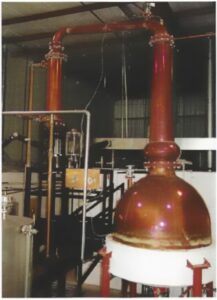The previous article in this series discussed how the production of Scotch whisky is very closely regulated by the Scotch Whisky Act of 1988. The only country where the production of beer is as closely regulated is Germany, with its Purity Law of 1516. Malt and grain spirits are mashed, fermented, distilled and matured separately, whereas in brewing, malt and adjuncts are usually processed together to produce a single malt.
In Scotch whisky production, higher diastatic power (DP) malts are employed. Extract, attenuation and carbohydrate-to-alcohol efficiencies are critical. Wort for spirit is unboiled, with no trub removal or cold break. As a consequence, this wort is not sterile, being contaminated with bacteria, mycelial fungi and wild yeasts. Spent grains are not removed from the grain wort but are removed (with a mash tun, lauter tun or mash filter) from spirit wort. Hops are not employed in the production of whisky.
Generally, only strains of Saccharomyces cerevisiae (ale type) are employed for the fermentation of whisky wort. This includes spent brewer’s yeast and “special” strains of yeast that can metabolise small dextrins (maltotetraose, maltopentose, etc.). Fermentation is conducted at higher temperatures than with brewing (25–32°C), in different geometry fermenters. At the end of fermentation, the yeast is not moved or recycled from the wash; it goes directly into the wash still or the Coffey still.
The fermented wort (wash) is distilled, and a plethora of flavor congeners result in the distillate. This distillate is matured for a considerably longer period than in brewing (years, not days or weeks), and this occurs in oak casks. As with breweries that use high-gravity techniques, the distillate is diluted to an agreed alcohol specification (a minimum of 40% abv for Scotch whisky) at the end of the maturation period, but the characteristics of the dilution water employed are different. The final whisky in the bottle is far more stable than beer. There are no dissolved oxygen, light, foam or microbiological-stability problems. However, as with beer, haze formation can be a problem.
Both industries have strengths and weaknesses, and each can learn from the other. As already described, the Scotch whisky industry closely and jealously protects its heritage and tradition. The Scotch Whisky Act is the focus of this tradition, and the malt distilleries have developed the appropriate atmosphere, PR facilities and locations. Many (though not all) large breweries have lost this tradition, to their detriment. However, smaller brewing companies (such as the independent, family-owned breweries in the United Kingdom, and the microbreweries in North America and Japan) are striving to present an image of conservatism and tradition.
In conclusion, the Scotch whisky industry process has a number of differences with brewing, in addition to distillation of the fermented wort (wash). A brewery has traditionally been an integrated operation containing all the processes essential to brewing: fermenting, maturing, filtering, packaging and distributing the beer into the marketplace, or at least to a distribution depot. In contrast, an individual distillery is, for most of its output, but one of a number of feeder units supplying a selection of blends that formulate and package the final whisky. In recent years, however, the “standalone” operation of many breweries is changing, with beer being brewed in one location and tinkered to another where it is blended, diluted and packaged.
The next article will discuss the maturation of Scotch whisky and compare it to the beer maturation systems.









